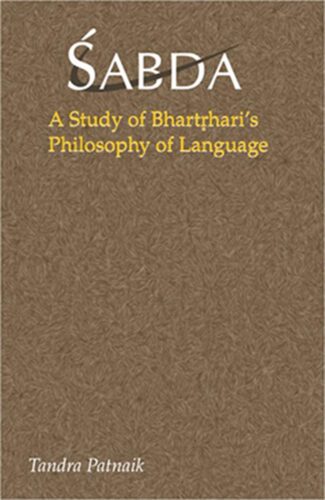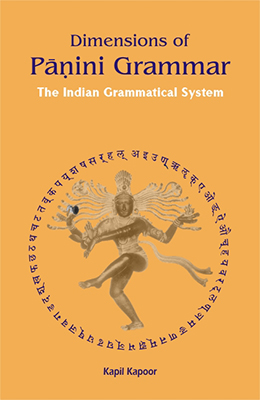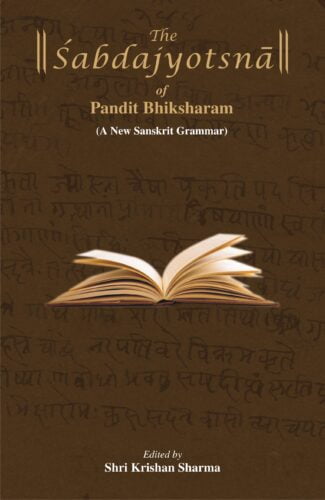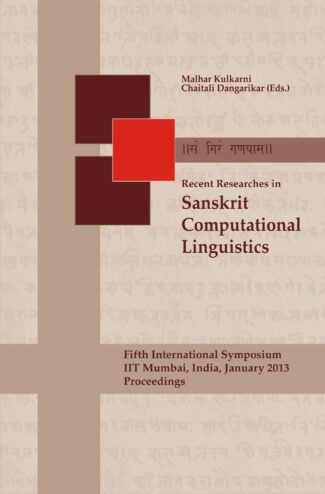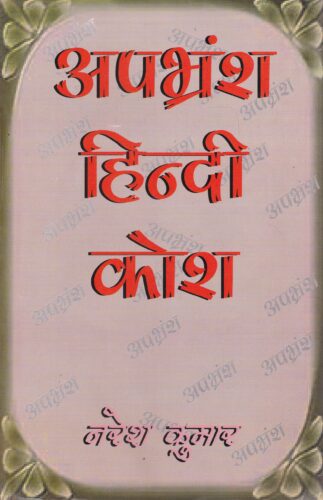

Apbharamsa Hindi Kos...
Apbharamsa Hindi Kosha
Apabhramsa-Hindi-Dictionary by: Naresh KumarThis Dictionary of Hindi Apabhramsa gives in detail the grammatical importance of words, their meanings, correct spellings, the alternate words and their various usages as mentioned by lexicographer Naresh Kumar.
₹1,500.00 Original price was: ₹1,500.00.₹1,350.00Current price is: ₹1,350.00.
ISBN: 9788124601365
Year Of Publication: 1999
Edition: 1st
Pages : xlv, 869
Language : Hindi
Binding : Hardcover
Publisher: D.K. Printworld Pvt. Ltd.
Size: 23 cm.
Weight: 1500
This Dictionary of Hindi Apabhramsa gives in detail the grammatical importance of words, their meanings, correct spellings, the alternate words and their various usages as mentioned by lexicographer Naresh Kumar.

- Sale!Sabda by: Tandra Patnaik
₹800.00Original price was: ₹800.00.₹720.00Current price is: ₹720.00.It is the first ever study of the fifth-century scholar, Bhartriharis Vakyapadiya in an altogether modern, the post-Fregean, perspective on the Philosophy of Language. A uniquely original thinker in Indias splendid grammarians tradition, Bhartrihari overreached the limits of language analysis set by his predecessors like Panini and Patanjali constructing, as he did, a brilliant Philosophy of Language that sought to spell out, among other aspects, the subtle distinctions between the knowable and the sayable, between what is said and what is meant, between the semantics of everyday speech and literary discourse. Sadly, Bhartrihari has, through the centuries, suffered neglect, largely because the Grammarian School never figured in the six major systems of traditional Indian philosophy.
For the first time, this monograph tries to reinterpret Bhartriharis position as a philosopher, emphasizing the high relevance of his Vakyapadiya to modern Western thought. A reputed scholar of grammar, philosophy and Sanskrit studies, the author presents Bhartriharis analyses of language methodically, unbiased. And, significantly, in contemporary philosophical idiom with contextual focus on the views of modern Western philosophers: Frege, Wittgenstein, Grice, Austin, Davidson, Searle, Strawson and the like. Also offered here is a lucid exposition of the Sphota Theory.
Growing from Dr Patnaiks a decade-long research on Bhartriharis philosophy, the volume highlights not only ancient Indian contribution to the study of language, but the interconnectedness among its indigenous approaches to linguistics, philosophy, logic and aesthetics as well. - Sale!Dimensions of Panini Grammar by: Kapil Kapoor
₹950.00Original price was: ₹950.00.₹855.00Current price is: ₹855.00.Leonard Bloomfield described Panini’s Ashtadhyayi (7th century bc) as ‘one of the greatest monuments of human intelligence.’ It is a complete, explicit and comprehensive grammar of both spoken and textual (compositional) Sanskrit. Most of the reputed and renowned Indian and foreign universities running courses on Indian knowledge systems, study it for its principles of analysis, organization and description. What is of great interest is the theoretical framework that informs this grammar, a framework that has remarkable power to describe human languages, particularly the Indian languages.
Panini is the watershed in the linguistic history of India. Before Panini, there was extensive work in phonetics, in morphology and lexicon (in the patha tradition) and in nirvacana (etymology). There is evidence also of the existence of several schools of grammar. In what is characteristic of the Indian intellectual traditions, Panini distilled the available grammatical knowledge and put it in 32000 syllables — as if, it has been said, an ocean has been accommodated in a cow’s hoof-mark. After Panini, a whole tradition developed and produced rich works by Patanjali, Candrakirti, Jainendra, Bhartrihari, Bhojraja, Hemacandracarya, Bhattoji Dikshita, Nagesha Bhatta and many others. It also inspired work in literature and philosophy and has left its mark on the entire intellectual tradition. In the modern period, there is a spread of Ashtadhyayi studies round the globe and it has proved to be of great interest for the study of knowledge representation in the departments of system sciences.
A comprehensive study of the different dimensions of this wonderful grammar enlarges and alters the conceptual horizons of young minds and of all those who care to be associated with the Indian grammatical systems. This book is a record of that adventure. - Sale!Meaning of Nouns by: Madhav M. Deshpande
₹1,000.00Original price was: ₹1,000.00.₹900.00Current price is: ₹900.00.Kaundabhatta’s Vaiyakarana-bhushana is a massive work on semantic theory written in India in the 17th century. Kaundabhatta belonged to the tradition of Sanskrit grammar and in this work he consolidated the philosophy of language developed in the Paninian tradition of Sanskrit grammar. His work takes account of the philosophical debate which occurred in classical and medieval India among the philosophers and grammarians from about 500 bc. to the 17th century ad and primarily represents this debate between the traditions of Sanskrit grammar, Mimamsa, and Nyaya-Vaisheshika. It discusses ontological, epistemological, and exegetical issues concerning the notion of meaning as it relates to the various components of language. The present book is a heavily annotated translation of the Namartha-nirnaya section of Kauandabhatta’s Vaiyakarana-bhushana, with an extensive introduction. While there are several books that discuss Indian semantic theories in general terms, this book belongs to a small class of intensive, focused studies of densely written
- Sale!Sabdajyotsna of Pandit Bhiksharam by: Shri Krishan Sharma
₹250.00Original price was: ₹250.00.₹225.00Current price is: ₹225.00.Pt. Bihiksharam (18871975) composed the Sabdajyotsna with a view to teach Sanskrit grammar to an ordinary student in a simple style. The author adopts pratyahara, anuvritti, anubandha, etc. in his work to impart the abridgement on the pattern of Ashtadhyayi and Pratishakhyas. For this purpose, the author tries his best to simplify the tough process of learning Sanskrit grammar.
The sutras of the Shabdajyotsna are composed subject wise (according to prakarana) on the pattern of prakriya works. Only samjna- and sandhi-prakaranas of this work were published in 1958. The rest of the text in Devanagari remained in the form of manuscript lying unattended. The script, whatever traced, was made available to Prof. Shri Krishan Sharma for the editing purposes by his grandson. However, the samasa-prakarana and some portions of taddhita-prakarana still remain untraceable.
In spite of some minor gaps, the work deserves recognition and appreciation in the academic circle. The author of the Sabdajyotsna aimed at and indeed succeeded in fully exposing the rules of Sanskrit grammar in lucid and clear diction.
The work, a pioneering attempt of its kind, may very well be considered as a significant contribution to the tradition of Sanskrit grammar, benefiting students, teachers and researchers alike. - Sale!Recent Researches in Sanskrit Computational Linguistics by: Malhar Kulkarni, Chaitali Dangarikar,
₹700.00Original price was: ₹700.00.₹630.00Current price is: ₹630.00.This volume is the proceedings of the 5th International Sanskrit Computational Linguistics Symposium (ISCLS), held at IIT Bombay during 4-6 January 2013. These proceedings include fourteen selected and three invited papers. The selected papers deal with topics such as computational modelling of Panini’s grammar Ashtadhyayi together with its supplementary texts, computational tools for Sanskrit language and their applications in the traditional Sanskrit concerns. Accordingly, this book delves upon how clues from Ashtadhyayi help in identifying compound types; how Ashtadhyayis digital edition can be structured and implemented; the completeness analysis of a Sanskrit reader; graph-based analysis of parallel passages; some relation-specific issues in parsing Sanskrit texts, text normalizer for Sanskrit; extended Nyaya-Vaisheshika ontology; and a search engine for Sanskrit, among others.
The invited papers focus on lexicography, with special reference to Encyclopaedic Dictionary of Sanskrit on Historical Principles; some aspects of semantics in early India in understanding the meaning of words; and the computational database of Paninis grammar.
This collection, thus, is an important initiative in the filed of Sanskrit computational linguistics as it records insightful current trends in the field, making it a must buy for students, researchers, and all those interested in Sanskrit grammar.



